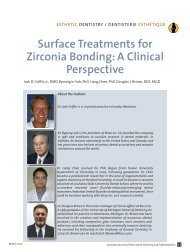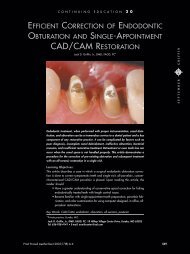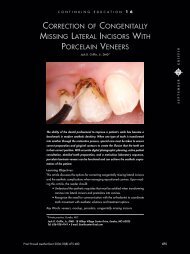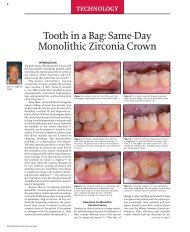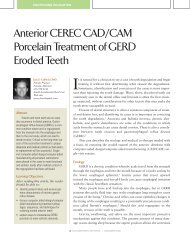Conservative Zirconia Bridge for Anterior Tooth Replacement
Conservative Zirconia Bridge for Anterior Tooth Replacement
Conservative Zirconia Bridge for Anterior Tooth Replacement
You also want an ePaper? Increase the reach of your titles
YUMPU automatically turns print PDFs into web optimized ePapers that Google loves.
3<br />
AESTHETICS<br />
<strong>Conservative</strong> <strong>Zirconia</strong> <strong>Bridge</strong>...<br />
continued from page 00<br />
tried <strong>for</strong> many years with varying<br />
degrees of success and failure. An<br />
increase in adherence may make their<br />
use more attractive in future planning.<br />
Reliable adhesion, proper abutment<br />
preparation using boxes of a single<br />
insertion path, and group function<br />
or bicuspid disclusion can all be factors<br />
affecting predictable long-term<br />
success. 21,22<br />
Despite minimal chemical adhesion<br />
with zirconia using traditional<br />
bonding systems, micromechanical<br />
retention has been sufficient <strong>for</strong> complete<br />
coverage restorations. 23 Studies<br />
have been somewhat encouraging<br />
with some silanization techniques,<br />
but higher bond strengths <strong>for</strong> conservative<br />
restorations would be a significant<br />
advantage. 24,25 A zirconia<br />
primer, Z-Prime Plus (BISCO Dental<br />
Products) has been developed that has<br />
been shown to significantly increase<br />
the shear bond strength of 4 different<br />
light-cured and self-cured resin<br />
cements (BisCem [BISCO Dental<br />
Products], Unicem (3M ESPE), Bisfix<br />
SE (VOCO America), SmartCem 2<br />
[DENTSPLY Caulk]), according to<br />
research conducted at Bisco Inc. in<br />
2010. The author considers the use of<br />
primers on indirect substrates in<br />
retentive cases as an improved means<br />
to seal this interface and reduce water<br />
penetration between the cement and<br />
the zirconia undersurface.<br />
For restorations that have short<br />
clinical crowns, or where resistance<br />
<strong>for</strong>m is lacking, it is helpful to have a<br />
primer that will work on materials<br />
that are nonsilica based to increase<br />
retention of the restoration. 26,27 Ma -<br />
terials such as zirconia, alumina, and<br />
metal have no glass component, so traditional<br />
etching with HFl is not effective.<br />
The phosphate monomers <strong>for</strong>m<br />
the basis <strong>for</strong> chemical bonds between<br />
the zirconia and the primer, allowing<br />
<strong>for</strong> a cohesive bond to the resin<br />
cement. This reliable bond over time is<br />
critical, especially in a minimally<br />
retentive case with conservative<br />
bridge abutments, as in the case that<br />
follows. 28,19<br />
CASE REPORT: CONSERVATIVE<br />
REPLACEMENT OF TOOTH NO. 11<br />
Treatment Plan<br />
A 58-year-old woman had a retained<br />
deciduous tooth “h” with a mesioangular<br />
impacted tooth No. 11 extending<br />
under teeth No. 9 through No. 12<br />
(Figure 1). <strong>Tooth</strong> “h” had become<br />
mobile over the last year and reached<br />
the point of severe pain upon touch<br />
Figure 5. Extraction of “h” was uneventful<br />
and the mesial papilla was quite good, but<br />
there was slight blunting of the distal papilla.<br />
Figure 8. Granulation tissue was removed<br />
and a graft material placed in the extraction<br />
site. Be<strong>for</strong>e the temporary bridge was<br />
cemented, a collagen membrane was laid<br />
over the site to keep cement from moving<br />
toward the graft.<br />
Figure 11. Impressions and models were<br />
accompanied by photos and a CD<br />
containing all images taken be<strong>for</strong>e and<br />
during the procedure.<br />
with grade 3 mobility. The tooth was<br />
deemed hopeless and extraction was<br />
indicated (Figure 2). She had a 3-mm<br />
overjet and a one-mm deep bite with<br />
no centric contact on the lingual of<br />
the maxillary incisors. Her occlusion<br />
in lateral movements was in group<br />
function with the cusp tip of tooth<br />
No. 6, slightly worn with generalized<br />
enamel crazing. This occlusal scheme<br />
would provide a more suitable situation<br />
<strong>for</strong> a conservative bridge than<br />
someone with a more advanced deep<br />
bite, heavy cingulum contact, and evidence<br />
of parafunctional habits. The<br />
incisal aspect of tooth No. 9 had an<br />
asymptomatic fracture from trauma<br />
several years earlier.<br />
Surgical exposure of tooth No. 11<br />
with orthodontic ligation and traction<br />
was ruled out because of the<br />
unpredictability of <strong>for</strong>ced eruption in<br />
adults and the patient’s desire to avoid<br />
orthodontics. Because of the position<br />
Figure 6. After tooth preparation a temporary<br />
was made with a dual-cure composite<br />
in a matrix from the pre-op condition of the<br />
tooth.<br />
Figure 9. After 3 months of healing, the<br />
temporary was removed and a good ovate<br />
<strong>for</strong>m was present. The preparations were<br />
refined and impressions taken.<br />
Figure 12. The lab was instructed to remove<br />
a slight amount of stone (about 0.5 mm) in<br />
the pontic area so that the bridge would put<br />
slight pressure on the soft tissues <strong>for</strong><br />
support.<br />
of the impacted tooth, an oral surgeon<br />
felt that the extraction, bone grafting,<br />
and implant placement would be<br />
unpredictable.<br />
More extensive cosmetic/restorative<br />
treatment was ruled out <strong>for</strong> financial<br />
reasons and the patient’s request to<br />
not have teeth “ground on” (Figure 3).<br />
The accepted plan was <strong>for</strong> extraction of<br />
“h,” a conservative zirconia framework/porcelain<br />
bridge to replace tooth<br />
No. 11, use of composite on tooth No. 9<br />
and the mesial of tooth No. 10 to<br />
improve aesthetics, and on tooth No. 6<br />
to restore the cusp tip (Figure 4).<br />
Preparation of Tissues<br />
After administration of local anesthetic,<br />
the deciduous tooth “h” was extracted,<br />
granulation tissue was removed,<br />
and the abutment teeth were prepared<br />
using a medium grit tapered diamond<br />
(Figure 5). The lateral incisor was prepared<br />
with 1 to 1.5 mm reduction with<br />
Figure 7. Composite was placed on the<br />
tissue side, making a convex surface in all<br />
directions <strong>for</strong> tissue adaptation. The<br />
material was added and slight blanching of<br />
the tissues verified.<br />
Figure 10. Photos of the teeth to be<br />
matched were taken <strong>for</strong> the ceramist.<br />
Figure 13. The bridge framework of zirconia<br />
was covered with an add-on porcelain <strong>for</strong><br />
aesthetics.<br />
a rounded shoulder and 1.5 mm deep<br />
seating grooves placed on the mesial<br />
and distal aspects of the preparation.<br />
The box on the distal was 2 to 3 mm<br />
into the tooth and 3 to 4 mm in height<br />
from gingival to incisal.<br />
The composite on the bicuspid was<br />
removed and the lingual cusp reduced<br />
<strong>for</strong> about 2 mm of clearance in excursive<br />
movements. Interproximal box<br />
preparations with a width and height<br />
of about 3 mm were done to provide a<br />
dovetail with a definite path of insertion<br />
and to provide bulk <strong>for</strong> connectors.<br />
These boxes were made parallel<br />
with a limited path of insertion complimenting<br />
the preparation of the lateral<br />
incisor to decrease chances of displacement<br />
and to increase surface area<br />
<strong>for</strong> luting material bonding.<br />
A composite temporary restoration<br />
(Luxatemp [DMG America]) with<br />
an ovate type pontic was fabricated<br />
continued on page xx<br />
DENTALCETODAY.COM • NOVEMBER 2011



